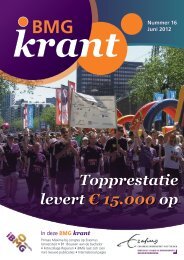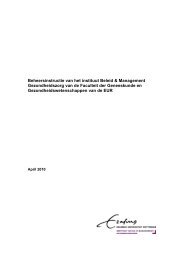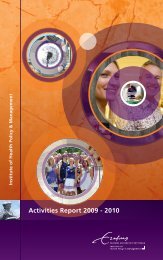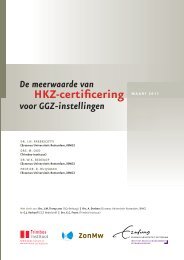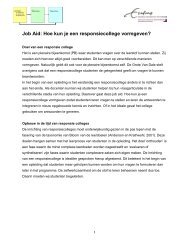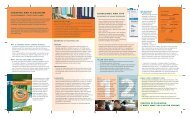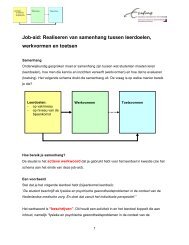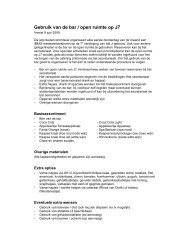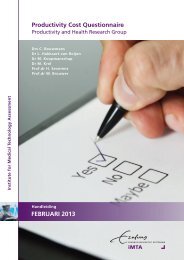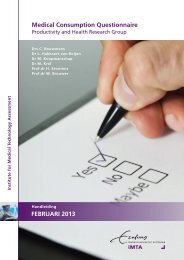126Chapter 88.1 INTRODUCTIONThis thesis has focused on the cost-effectiveness of neonatal surgery. Its mainconclusion is that neonatal surgery is costly, but worth the expense. Thisconclusion holds both for the entire treatment processes for two prevalentdiagnostic groups (i.e., congenital anorectal malformations (ARM) and congenitaldiaphragmatic hernia (CDH); Chapters 2 to 4) and for a particular treatmentmodality (i.e., extracorporeal membrane oxygenation (ECMO); Chapter 5). Theencouraging outcomes do not change when the position of the parents isconsidered (Chapter 6). Neither do they change when it is recognized thatarguments other than cost-effectiveness have a role at the social choice level(Chapter 7).Summarized so briefly, these conclusions seem clear and not open to ambiguousinterpretation. Yet, there are many ways to see things. Things may look quitedifferent if alternative perspectives are taken. Therefore, in this final chapter, wewould like to invite the reader on an imaginary tour along different perspectivesof the results presented in the preceding chapters, with each perspective beinguseful for different audiences with different needs. Additionally, it can stimulatethe different audience groups to remain aware of their own frame of referenceand to keep their minds open to other points of view. During the tour, we willstop at four locations, taking the perspectives of, respectively, the child and his orher parents, the pediatric specialist, society and its agents (the decision makers),and the health economics researcher. After having taken the four differentperspectives, we will reconsider the main conclusions stated above.8.2 PERSPECTIVE 1: THE CHILD AND HIS OR HER PARENTSThe first part of our tour explores the results from the perspective of the patientand his or her parents. The results that will most likely catch the eye of thepatient and his or her family include our findings on the mortality attributable toneonatal surgical diseases. Analogous to the observation presented in Chapter 1that mortality rates for almost all anomalies belonging to the field of neonatalsurgery have dropped markedly, mortality rates for ARM were found to be low bynow. Of all 179 patients born in the most recent decade (from 1987 to 1996) ofthe study period of the research described in Chapter 2, 18 (10%) had died.However, we found CDH to be associated with still high mortality rates, despitethe many advances in treatment over recent decades (Chapter 3). The mortalityrate was 39% (44 out of 114), for example, in the patients born from 1987 to1996.When confronted with the birth of a child with a major congenital anomaly, theparents are anxious to know not only whether their child will live, but also whatquality of life to expect. For this reason, this thesis set out to study the health-
General Discussion: A Guided Tour Providing Four Different Views of the Results 127related quality of life (HRQoL) of survivors of ARM and CDH from childhood toadulthood (Chapter 4). A discussion of the findings of this study is preceded hereby the following point, which is that it appeared essential to include various typesof outcome measures to gain a full understanding of the long-term outcomes ofneonatal surgical diseases—a point equally relevant to the researcher (see furtherSection 8.5). Each type can capture patient outcomes that the others cannotreveal. A first measure of health includes biological and physiological factors,which focus on the function of cells, organs, and organ systems. Then, anindividual may or may not have the perception of an abnormal physical,emotional, or cognitive state (which can be termed 'symptoms'). On anotherlevel, there may occur problems in body function or structure, such as loss ofvision or loss of a leg. Then, one may want to study physical, social, or emotionalfunctional status, that is, the ability of the individual to perform particular definedtasks. Finally, to estimate the significance to an individual of impairments orlimitations in functioning, HRQoL measures should be used—containing physical,mental, and social domains. To convey the full effect of the disease from theperspective of the patient, or the parent on his or her behalf, measuring HRQoLshould be an important component of long-term follow-up. The research by VanDeurloo from the Netherlands on esophageal atresia is a noteworthy example ofanother recent study in neonatal surgery that differentiated between a broadvariety of outcome measures. 1 The outcomes studied included esophagealfunction, gastrointestinal symptoms such as dysphagia or gastroesophagealreflux, limitations in daily life functioning, and generic HRQoL.Our examination in patients with surgically corrected ARM using different outcomemeasures produced a mixed picture. The patients appeared to retain substantialresidual symptomatology. Their HRQoL was somewhat lower than that of thegeneral population, especially for the youngest patients. Nonetheless, theirHRQoL improved considerably with age, beyond the level that we expected apriori. This finding was essentially confirmed in a recent Dutch nationwide studyin adult patients with ARM that used the same generic HRQoL questionnaire(SF-36) and arrived at largely the same HRQoL scores. 2 A couple of other recentHRQoL studies in patients with ARM did not include a comparison with a referencegroup, but studied the effect of new treatment modalities on HRQoL. The resultssuggest that individualized biofeedback training 3 and artificial bowel sphincterimplantation or the gracilis neosphincter procedure 4 can improve patients' HRQoL.These are relevant findings, and more such studies should be carried out with theaim of optimizing the management of this patient group. After all, as this thesisshowed, there is room for seeking to improve the HRQoL of especially theyoungest patients with ARM.From a comparison with the general population we found that the patients withCDH experienced disease-specific symptoms such as respiratory difficulties andstomach aches. However, the HRQoL of adolescent and adult CDH survivors couldhardly be distinguished from that of the general population. It is interesting to
- Page 3:
COST-EFFECTIVENESS OF NEONATAL SURG
- Page 6 and 7:
DOCTORAL COMMITTEEPromotors:Prof.dr
- Page 9 and 10:
PUBLICATIONSChapters 2 to 7 are bas
- Page 11:
6ChapterINFORMAL CARE FOR CHILDREN
- Page 14 and 15:
2Chapter 11.1 BACKGROUND AND MOTIVA
- Page 16 and 17:
4Chapter 1provides a good overview
- Page 18 and 19:
6Chapter 1disability, and death of
- Page 21:
Introduction 9particular equity pri
- Page 25 and 26:
Introduction 1320. Oostenbrink JB,
- Page 27 and 28:
Introduction 1554. Heyman MB, Harma
- Page 29 and 30:
THE COST-EFFECTIVENESS OFTREATMENT
- Page 31:
Cost-Effectiveness of Treatment for
- Page 35 and 36:
Cost-Effectiveness of Treatment for
- Page 37 and 38:
Cost-Effectiveness of Treatment for
- Page 39 and 40:
Cost-Effectiveness of Treatment for
- Page 41 and 42:
Cost-Effectiveness of Treatment for
- Page 43 and 44:
Cost-Effectiveness of Treatment for
- Page 45:
Cost-Effectiveness of Treatment for
- Page 48 and 49:
36Chapter 3ABSTRACTBackground/Purpo
- Page 50 and 51:
38Chapter 33.2 MATERIALS AND METHOD
- Page 52 and 53:
40Chapter 3child's date of birth) a
- Page 54 and 55:
42Chapter 3diaphragm was closed (Ta
- Page 56 and 57:
44Chapter 3Total costs of treatment
- Page 58 and 59:
46Chapter 3Regarding the treatment
- Page 60 and 61:
48Chapter 3REFERENCES1. Stolk EA, P
- Page 62 and 63:
50Chapter 332. Jaillard S, Pierrat
- Page 64 and 65:
52Chapter 4ABSTRACTAims:To examine
- Page 66 and 67:
54Chapter 4Outcome measuresThe pati
- Page 68 and 69:
56Chapter 4Clearly, the symptoms st
- Page 70 and 71:
58Chapter 4The respondents did not
- Page 72 and 73:
60Chapter 4Table 4.4TAIQOL Scores o
- Page 74 and 75:
62Chapter 44.4 DISCUSSIONIn this pa
- Page 76 and 77:
64Chapter 4ACKNOWLEDGMENTSWe are in
- Page 78 and 79:
66Chapter 418. Coons SJ, Rao S, Kei
- Page 80 and 81:
68Chapter 5ABSTRACTObjective:Extrac
- Page 82 and 83:
70Chapter 5treatment. 26,27 Finally
- Page 84 and 85:
72Chapter 5CostsOnly direct costs w
- Page 86 and 87:
74Chapter 5summarized in Table 5.2.
- Page 88 and 89: 76Chapter 5Table 5.3 Direct Medical
- Page 90 and 91: 78Chapter 5Figure 5.3 illustrates o
- Page 92 and 93: 80Chapter 5severely ill newborns—
- Page 94 and 95: 82Chapter 5REFERENCES1. Bartlett RH
- Page 96 and 97: 84Chapter 533. Meinert CL: Extracor
- Page 98 and 99: 86Chapter 568. Hui TT, Danielson PD
- Page 100 and 101: 88Chapter 6ABSTRACTObjective:To inv
- Page 102 and 103: 90Chapter 6a rule. The health-relat
- Page 104 and 105: 92Chapter 6Regression analysis of h
- Page 106 and 107: 94Chapter 6that caregiving for thei
- Page 108 and 109: 96Chapter 6Table 6.5 CareQol Compar
- Page 110 and 111: 98Chapter 6children with a disabili
- Page 112 and 113: 100Chapter 6This study was of impor
- Page 114 and 115: 102Chapter 618. Poley MJ, Stolk EA,
- Page 116 and 117: 104Chapter 654. Boman KK, Viksten J
- Page 118 and 119: 106Chapter 7ABSTRACTMortality rates
- Page 120 and 121: 108Chapter 77.2 THE RELEVANCE OF CO
- Page 122 and 123: 110Chapter 7In the early 2000s, our
- Page 124 and 125: 112Chapter 7Table 7.1 Economic Eval
- Page 126 and 127: 114Chapter 7More from a policy pers
- Page 128 and 129: 116Chapter 7also expect that life-s
- Page 130 and 131: 118Chapter 7entirely justified, for
- Page 132 and 133: 120Chapter 723. Sydorak RM, Nijagal
- Page 134 and 135: 122Chapter 765. Glaser AW, Davies K
- Page 137: GENERAL DISCUSSION:A GUIDED TOURPRO
- Page 141 and 142: General Discussion: A Guided Tour P
- Page 143 and 144: General Discussion: A Guided Tour P
- Page 145 and 146: General Discussion: A Guided Tour P
- Page 147 and 148: General Discussion: A Guided Tour P
- Page 149 and 150: General Discussion: A Guided Tour P
- Page 151: General Discussion: A Guided Tour P
- Page 154 and 155: 142GlossaryCharge (or: tariff)A pri
- Page 156 and 157: 144Glossaryefficient one. We are th
- Page 159 and 160: SUMMARY
- Page 161 and 162: Summary 149mortality. Finally, it i
- Page 163 and 164: Summary 151neonatal surgery. It is
- Page 165 and 166: SAMENVATTING
- Page 167 and 168: Samenvatting 155zoals directe niet-
- Page 169 and 170: Samenvatting 157Hoofdstuk 6 gaat ve
- Page 171: Samenvatting 159vereisen, waarvoor
- Page 174 and 175: 162AcknowledgmentsAlthough I am ind
- Page 176: About the AuthorBorn in De Meern (N





